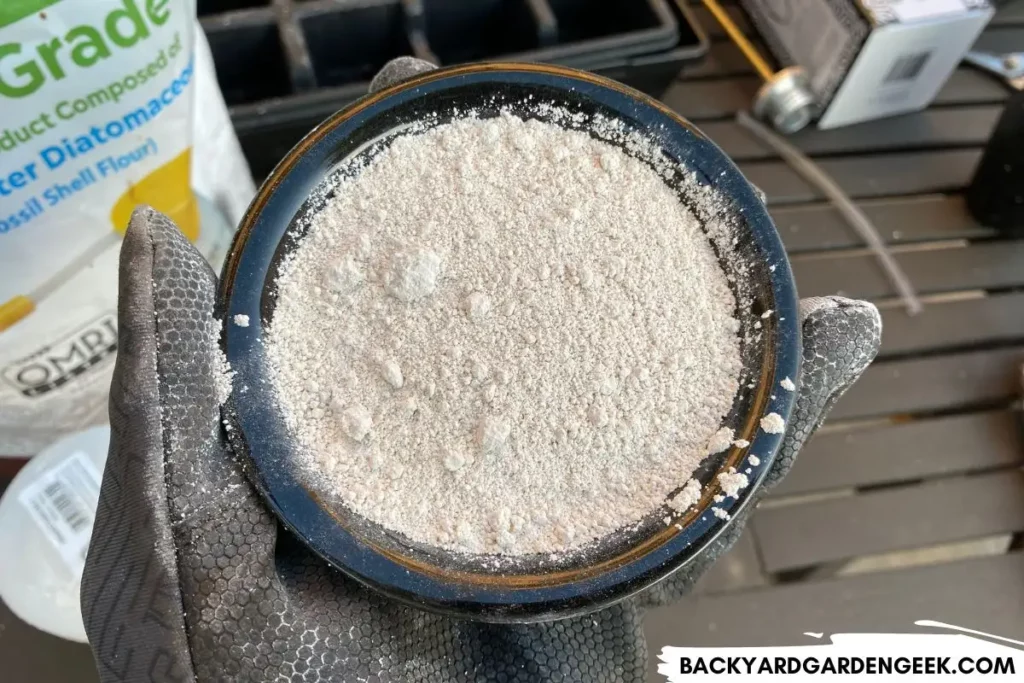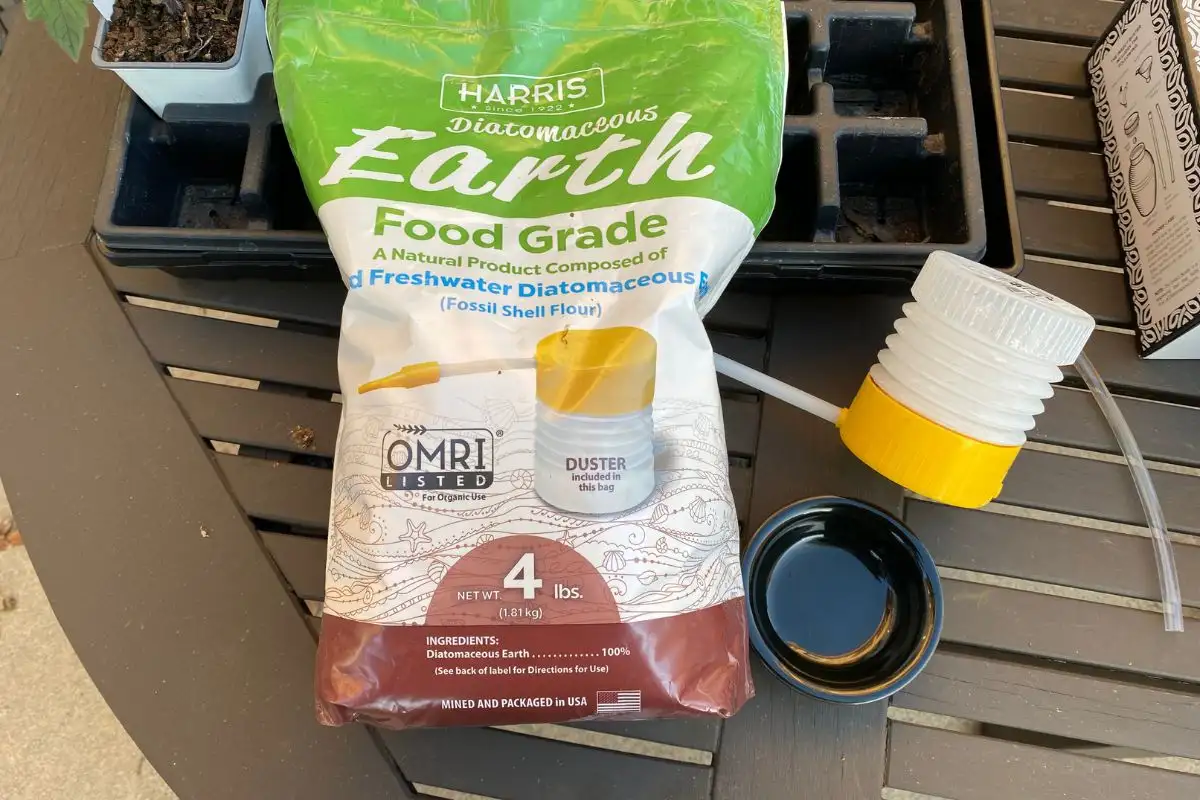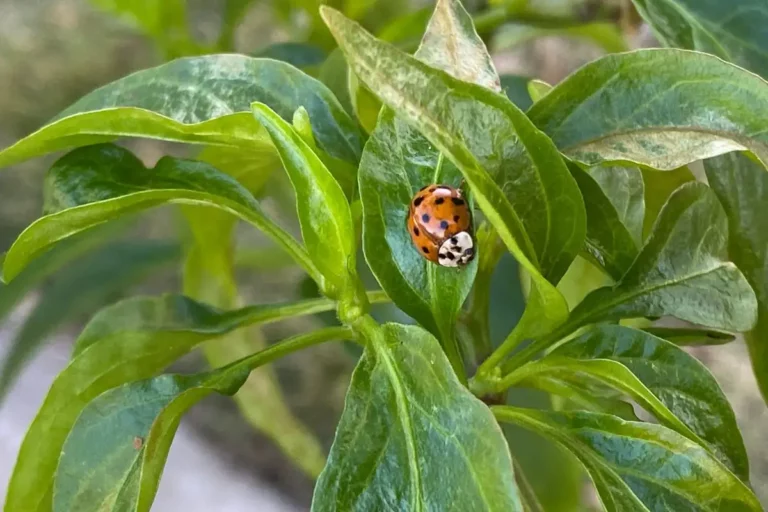Killing Ants with Diatomaceous Earth in 7 Easy Steps
Ants can be such a nuisance. Their tiny size and countless numbers make them a real headache to deal with, especially when they’ve settled among your garden plants.
Unlike chemical ant killers such as Amdro—which work great in non-garden lawns but shouldn’t be used anywhere near garden plants—diatomaceous earth is generally safe to use in or around your plants. But will it kill ants effectively?
Diatomaceous earth is an effective ant control product that’ll dehydrate and kill ants a few hours after contact. Once a nest had been located, DE should be liberally applied to the nest and its immediate surroundings. This method cuts off worker ants’ paths and directly targets the nest itself.
In this article, I’ll give you an overview of all you’ll need to know to combat any ants that have taken up residence among your plants.
Here’s what I’ll cover below:
- Some thoughts on how to determine if the ants in your garden are harmless or if they’re going to cause problems.
- My simple step-by-step guide to killing garden ants with diatomaceous earth.
- A few easy recommendations for determining the appropriate amount of DE to use for different ant infestation scenarios
- An explanation of how long it takes for DE to kill ants and the factors that might influence this process.
I’ve become a huge fan of DE over the past few years, so I’ve made it my mission to help others learn more about and start using this organic, non-toxic insecticide.
Keep reading if you’d like to learn more DE and how this eco-friendly product can help you reclaim your garden from the wrong kinds of ants.
7 Steps to Killing Ants with Diatomaceous Earth
If you’ve been gardening for any amount of time, you’ve likely seen ants among your plants. They love to climb around beans, carrots, okra, peas, peppers, and tomatoes. I’ve even seen them crawling around my lettuce at times.

Ants are a common sight in most gardens. While they might seem like a bother, the majority of ants are harmless and can even be beneficial to your garden ecosystem. They aid in breaking down organic material and improving soil structure.
So if you see ants crawling around your plants and investigating your flowers, don’t necessarily worry about them.
However, not all ants are garden-friendly. There are a few that you definitely need to act on if you see them in your garden:
- Fire Ants: These pose a threat due to their painful stings, which can even trigger allergic reactions in some individuals. Thankfully, my kids aren’t allergic to their stings, but whenever I see them, I want them out of my garden!
- Leafcutter Ants: I’ve never dealt with these plant destroyers (thank goodness!), but I know they can snip off foliage and make a mess of things.
- Ants + Aphids: If you spot ants near aphids, no matter the species, you know you’ve got a problem. Ants don’t attack or eat aphids. They actually protect aphid colonies, helping these little pests drain plant nutrients and secrete sticky honeydew that promotes sooty mold growth. Aphids attract ants, and in turn, the ants reciprocate by protecting aphids and making the aphid infestation worse.
In these scenarios, diatomaceous earth is a great option since you can use it on and around your plants.
But what exactly is DE, and how does it work?
Diatomaceous earth is a naturally occurring sedimentary mineral composed of fossilized diatoms—ancient microalgae that had hard, silica-based cellular structures.
When gathered and ground into a fine powder, DE becomes an effective insecticide. The powder feels floury to the touch—and wont’ harm you or your furry friends—but for insects, it’s sharp and deadly. It works by cutting into their exoskeletons, causing them to dehydrate and eventually die.

Now, let’s look at the process of using DE against ants. Here’s a quick overview of what I do in my garden.
(You’ll find more details about each step below this table.)
| Steps | Description |
|---|---|
| Step 1 | Check the weather to see if there’s any rain on the horizon. |
| Step 2 | Locate all of the nests in your garden and around your property. |
| Step 3 | Put on any protective gear you think you’ll need, then open a bag of food-grade DE. |
| Step 4 | Grab a bulb duster. This is one time when you can use a spoon as well. |
| Step 5 | Apply a ring of diatomaceous earth around all visible ant mounds. |
| Step 6 | Cover all visible ant mounds in a thick layer of DE. |
| Step 7 | Reapply every 4-7 days or after any rainfall, heavy dew, or watering. |
Here’s what I think about at each step of the process:
1. Check the Weather: DE works best in dry conditions. If the forecast predicts rain within the next few days, it’s better to wait until it’s clear. Rain will wash away the DE and reduce its effectiveness.
2. Locate the Ant Nests: Follow any ant trails you happen to see and do your best to locate their mounds. The best time for this is during the early morning or late afternoon when ants are most active. I usually have trouble tracing the ant trails, but I’m pretty good at spotting mounds, so just take a close look all around your garden and see what you can spot.
3. Suit Up: DE isn’t harmful to humans or pets, but it can be irritating if inhaled or if it gets in your eyes. When handling DE, I always wear gloves, and if it’s at all windy outside (even a slight breeze), I’ll put on a mask and goggles as well. But gloves are a must; otherwise, you’ll get floury DE all over your hands.
4. Grab a Bulb Duster or Spoon: I prefer Harris diatomaceous earth, and you’ll often get a plastic bulb duster in each, but high-quality bulb dusters work much better. I like Dr. Killigan’s bulb dusters since they do the job better than plastic ones. The 10-pound bags will usually be the most cost-effective. DE won’t expire or lose its effectiveness, so you can store it as long as you’d like. I normally wouldn’t use a spoon to apply DE, but in the case of ant mounds, it works just fine.
5. Apply DE Around Each Mound: Using a bulb duster or spoon, create a thick ring of DE around the mound. This will kill the ants coming out of the nest and those returning home as well.
6. Cover Mounds in DE: I like to take the added step of covering the mound itself in a heavy coating of DE to ensure that any ant going in or coming out gets covered in a little DE. It’ll take 24-48 hours for the DE to kill off any ants that came in contact with it, but over time, you’ll make it impossible for the worker ants to do their jobs.

7. Reapply As Needed: For larger ant mounds, I reapply DE every 3-4 days or after rain, heavy dew, or watering your garden (once all the moisture has dried). This ensures a continuous barrier against the ants.
Please note that DE is a non-selective insecticide. Thankfully, it won’t harm earthworms, but it’ll kill bees and butterflies and ladybugs if it ever gets on them. Whenever you use it, do so judiciously and only when you’re dealing with fire ants, leafcutter ants, or ants protecting aphids.
Just remember that you’ve got to tackle your aphid problems first if you’ve got them in your garden, or you’ll never be able to fully take care of your ant problems.
I’ve written a lot about aphids, so if you’re curious to learn more, take a look at these articles:
- 11 Destructive Ways That Aphids Harm Plants
- 12 Reasons Why Aphids Keep Coming Back + 3 Simple Fixes
- 21 Plants That Aphids Love to Attack + How to Stop Them
- Are Aphids Safe to Eat? Handling Aphid-Infested Vegetables
- Can Aphids Survive If Sprayed, Soaked, or Doused with Water?
- Can Plants Recover from Aphids? Tips to Save Your Plants
- Can You See Aphids on Plants? Spotting Early Infestations
By using DE correctly, you can keep harmful ants in check while preserving the friendly ones that contribute to your garden’s health.
How Much Diatomaceous Earth Do I Need to Use on Ants?
When it comes to using diatomaceous earth to kill ants, you’ll be wasting your time if you try applying DE to individual ants or ant trails. You’ll instead need to target their nests directly if you want to get rid of them.
As I noted above, I apply DE to ant mounds in 2 ways:
- Bulb Duster: This is really easy. Just point the nozzle close to the ground and squeeze. You’ll discharge a puff of DE that’ll cover the area around the mound. You can then coat the entire next in it.
- Large Spoon: Spoons are not that great for most occasions, but they work well against ants. Simply get a spoonful of DE, then sprinkle the DE around the mound to create a helpful barrier. Afterward, you can use the spoon to apply DE atop the mound itself.
I create a DE barrier because I want to make sure that ants entering or leaving the next have to cross it, injuring themselves in the process.
The goal of creating this barrier is to ensure that any ants entering or leaving the nest must cross the DE-covered area. By forcing the ants to cross this DE barrier, you’ll be ensuring the slow but steady death of the ant colony.
While I typically don’t apply DE with anything other than a bulb duster, this is the one exception to the rule. Covering ant mounds in DE is actually pretty easy when using a spoon.
Long story short, an ant nest thoroughly coated in DE and surrounded by a DE barrier will significantly increase the chances of worker ants coming into contact with DE. This’ll lead to a reduction in the overall ant population.
By the way, if you’re interested in looking at other ways to handle ants, you might be interested in these articles:
- Ant Prevention with Essential Oils: Are They Safe for Cats?
- Do Ants Hate the Smell of Peppermint? Here’s What to Know
- Preventing Ants with Essential Oils + Keeping Dogs Safe
- Will Neem Oil Kill or Repel Ants? All You Need to Know
How Long Does It Take for Diatomaceous Earth to Kill Ants?

As I noted above, diatomaceous earth doesn’t kill ants on contact. Once it gets on them, it cuts into their exoskeletons and begins absorbing their lipids and moisture.
The process isn’t immediate. Depending on the ant’s size, dehydration and death can take anywhere from 12-48 hours. Larger ants, like carpenter ants, may take up to 48 hours to die, while smaller species, such as common black ants, may die within 12 hours or less.
Unfortunately, getting rid of an entire ant colony isn’t just about killing visible worker ants. Colonies have a queen, and her job is to lay eggs to ensure the colony’s survival.
While DE starts killing the worker ants within hours, it’ll take some time to wipe out a colony since the queen will need to die for that to happen.
Remember that DE only works when it’s dry. Rain or heavy dew can render the DE ineffective, so you’ll need to reapply it after such events. Moreover, DE will scatter over time due to wind and other factors, so regular reapplication every 3-4 days will ensure a consistent DE barrier around the ant mound.
The next time you notice an ant colony setting up home in your garden, get out your bag of DE, find the ant mounds, and apply the DE liberally in and around them. That’s all you need to do to minimize unwanted ants around your plants.
More Information
I’ve written about both ant infestations and the use of diatomaceous earth as an insecticide, so if you’d like to learn more about those topics, check out these articles:
- 4 Reasons Why Diatomaceous Earth Will Kill Bugs
- 5 Reasons to Mix Diatomaceous Earth with Soil
- 57 Bugs That Diatomaceous Earth Kills or Keeps Away
- Can You Put Too Much Diatomaceous Earth on Plants?
- Diatomaceous Earth vs. Neem Oil: Which Should You Use?
- Using Diatomaceous Earth as a Fertilizer: Will DE Help?
- What Bugs Does Diatomaceous Earth NOT Kill?






